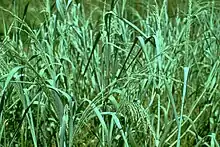Panicum amarum
Panicum amarum is a species of grass known by the common name bitter panicum. It is native to North America, where it is found in coastal regions along the East Coast and Gulf Coast of the United States and into northeastern Mexico. It also occurs in The Bahamas and in Cuba.[2]
| Panicum amarum | |
|---|---|
 | |
| Scientific classification | |
| Kingdom: | Plantae |
| Clade: | Tracheophytes |
| Clade: | Angiosperms |
| Clade: | Monocots |
| Clade: | Commelinids |
| Order: | Poales |
| Family: | Poaceae |
| Subfamily: | Panicoideae |
| Genus: | Panicum |
| Species: | P. amarum |
| Binomial name | |
| Panicum amarum | |
| Synonyms[1] | |
| |
This perennial grass grows from a thick rhizome. It has stems up to 2.5 meters tall and 1 centimeter thick. It may grow erect or bent over. The thick, firm leaves are up to half a meter long.[2] They are bluish in color.[3] The inflorescence is a narrowed panicle up to 80 centimeters long by 17 wide.[2] Some seed is produced but most reproduction is vegetative, with new plants sprouting from tillers and the rhizome.[4]
This grass is commonly used for dune stabilization projects.[5] It is used to prevent erosion.[6] The aboveground plant parts act as a windbreak, preventing the sand from being blown away, and the large root system stabilizes the sand in place.[4] It can also be used in revegetation projects at other areas, such as mine spoils.[6] Specifically, var. amarulum is valuable for these projects. The roots grow six feet deep. The cultivar 'Atlantic' is available.[7]
A cultivar of P. amarum called 'Dewey Blue' is also used for ornamental purposes.[8]
References
- "The Plant List: A Working List of All Plant Species". Retrieved 8 January 2015.
- Panicum amarum. Archived 2016-03-04 at the Wayback Machine Grass Manual Treatment.
- Panicum amarum. USDA NRCS Plant Fact Sheet.
- Panicum amarum. USDA NRCS Plant Guide.
- Hester, M. W., et al. (1994). Grazing of Panicum amarum in a Louisiana barrier island dune plant community: Management implications for dune restoration projects. Ocean & Coastal Management 23(3) 213-24.
- Learning about bitter panicum. LSU Coastal Roots.
- Panicum amarum var. amarulum. USDA NRCS Plant Fact Sheet.
- 'Dewey Blue'. Missouri Botanical Garden.
